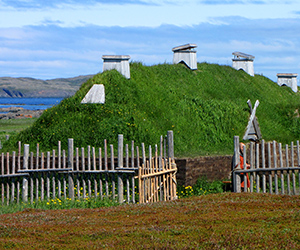CANADA HISTORY - Places-Homes
Bellevue House

Bellevue House, an architectural gem built in 1840 in Kingston, Ontario, played an important role in the life of Canada’s first Prime Minister, Sir John A. Macdonald. The house, designed in the style of a Tuscan villa, stood out as a unique structure in 19th-century Kingston. It was leased by Macdonald during a critical phase in his early career, from 1848 to 1849, when he was an ambitious young lawyer. During his time at Bellevue House, Macdonald lived with his first wife, Isabella, who was gravely ill, a fact that shaped much of their short time in the home. Today, Bellevue House has been extensively restored and is managed by Parks Canada, offering visitors a chance to step back into the formative period of Macdonald’s life and explore the home’s architectural and historical significance.
Origins of Bellevue House and Its Unique Architecture
Bellevue House was built by Charles Hales, a retired grocer, in 1840. Hales, like many affluent men of the time, desired a home that reflected both his wealth and his tastes, and he chose a style that was both rare and extravagant for Kingston: the Italianate or Tuscan Villa style. The house is notable for its stuccoed brick walls and distinctive features, including ornamental fretwork adorning the eaves, wide verandas, and tall, narrow windows. The design was a stark departure from the Georgian and Victorian styles more commonly seen in the region during the mid-19th century. Bellevue House’s unique architecture reflected the period’s romantic fascination with Mediterranean aesthetics, blending them with the natural beauty of its Canadian setting.
This architectural choice was a bold statement for its time, and the house’s exotic design made it stand out among the more conventional buildings of Kingston, then a small but growing town. Bellevue House also included a tower that offered sweeping views of the surrounding area, adding to its grandeur.
Political and Social Context: Macdonald’s Early Career
When John A. Macdonald leased Bellevue House in 1848, he was already gaining recognition as a rising lawyer and politician. Born in Glasgow, Scotland, in 1815, Macdonald had immigrated with his family to Canada when he was just five years old. Settling in Kingston, the Macdonald family became part of the burgeoning professional class, and John quickly made a name for himself as a lawyer. By the late 1840s, Macdonald had begun his political career as a member of the Legislative Assembly of the Province of Canada, representing Kingston. His reputation as a talented lawyer and astute politician was growing, but his time at Bellevue House coincided with a period of intense personal difficulty.
At the time, Macdonald’s first wife, Isabella Clark, was suffering from a severe, debilitating illness. Isabella’s health had deteriorated rapidly, and the couple’s move to Bellevue House was intended to provide a peaceful, healthy environment for her to recuperate. Despite their hopes, Isabella’s condition worsened during their time in the house, placing an immense strain on Macdonald. His letters from this period reveal a man torn between his professional obligations and his deep personal anguish over his wife’s health.
Macdonald’s time at Bellevue House also marked a formative period in his career. While he was caring for Isabella, he continued to build his reputation as a lawyer and politician, balancing his personal struggles with his rising political ambitions. This period laid the groundwork for Macdonald’s future achievements, as he would go on to become one of the architects of Canadian Confederation in 1867 and Canada’s first Prime Minister.
Life at Bellevue House and Isabella’s Illness
Isabella Clark Macdonald’s illness shaped much of the couple’s experience at Bellevue House. She suffered from a chronic condition, likely tuberculosis or a related illness, which left her bedridden for long periods. Isabella’s health struggles placed a significant burden on Macdonald, who was deeply devoted to her care. His letters and accounts from friends at the time describe his efforts to balance his demanding legal career with his role as a caregiver.
Life at Bellevue House was marked by the challenges of Isabella’s illness, but the house itself provided a tranquil setting during these difficult times. The spacious, well-ventilated rooms and expansive gardens offered some comfort and relief, but the peaceful surroundings could not change the realities of Isabella’s deteriorating condition. The couple’s son, John Alexander, was born during their time at Bellevue House but died just 13 months later, adding to the emotional toll on the family.
Despite these hardships, Bellevue House was a refuge for the Macdonalds, offering them a temporary escape from the pressures of public life. The house provided privacy and comfort during a period when Macdonald was navigating both personal tragedy and professional responsibilities.
Restoration of Bellevue House
Today, Bellevue House stands as a testament to both the architectural tastes of the 19th century and the personal story of John A. Macdonald and his first wife. The house has been extensively restored by Parks Canada to reflect the period of Macdonald’s habitation. This restoration, which began in earnest in the mid-20th century, sought to recreate the atmosphere of the house as it would have appeared during the Macdonalds’ time there.
The restoration involved detailed research into the home’s original furnishings, decor, and layout, with an emphasis on accurately portraying the domestic life of a prominent mid-19th-century family. The rooms have been furnished with period-appropriate furniture, much of it based on descriptions from Macdonald’s letters and other contemporary accounts. The gardens, which were an important feature of the house, have also been restored to reflect the landscaping typical of the era, providing visitors with a sense of the tranquility that the Macdonalds sought during their residence.
Bellevue House as a National Historic Site
Bellevue House is now a National Historic Site of Canada, managed by Parks Canada. The site serves as both a museum and an educational center, offering visitors insight into the life of John A. Macdonald, his family, and the early history of Canada. The house is a focal point for understanding the personal and political life of Canada’s first Prime Minister, especially during his formative years as a lawyer and politician.
The interpretive programs at Bellevue House focus on the broader historical context of Macdonald’s life, his achievements, and the challenges he faced. Visitors can explore the house’s restored rooms, engage with exhibits on Macdonald’s legal and political career, and learn about Isabella’s illness and its impact on the family. The site also offers educational programs that delve into the complexities of Macdonald’s legacy, including his role in shaping Canada’s political landscape and his controversial policies toward Indigenous peoples.
Bellevue House stands as an important piece of Canada’s heritage, offering a glimpse into the personal life of Sir John A. Macdonald during a critical period in his early career. The house’s unique architecture, its role as a refuge for Macdonald and his ill wife Isabella, and its restoration as a National Historic Site make it a valuable cultural and historical resource. Managed by Parks Canada, Bellevue House provides visitors with a deeper understanding of Canada’s first Prime Minister, the personal struggles he faced, and the broader historical context in which he rose to prominence. The house serves as a reminder of the human side of one of Canada’s most influential figures, offering a more nuanced perspective on his life and legacy.
Cite Article : Reference: www.canadahistory.com/sections/documents/documents.html
Source: NA



